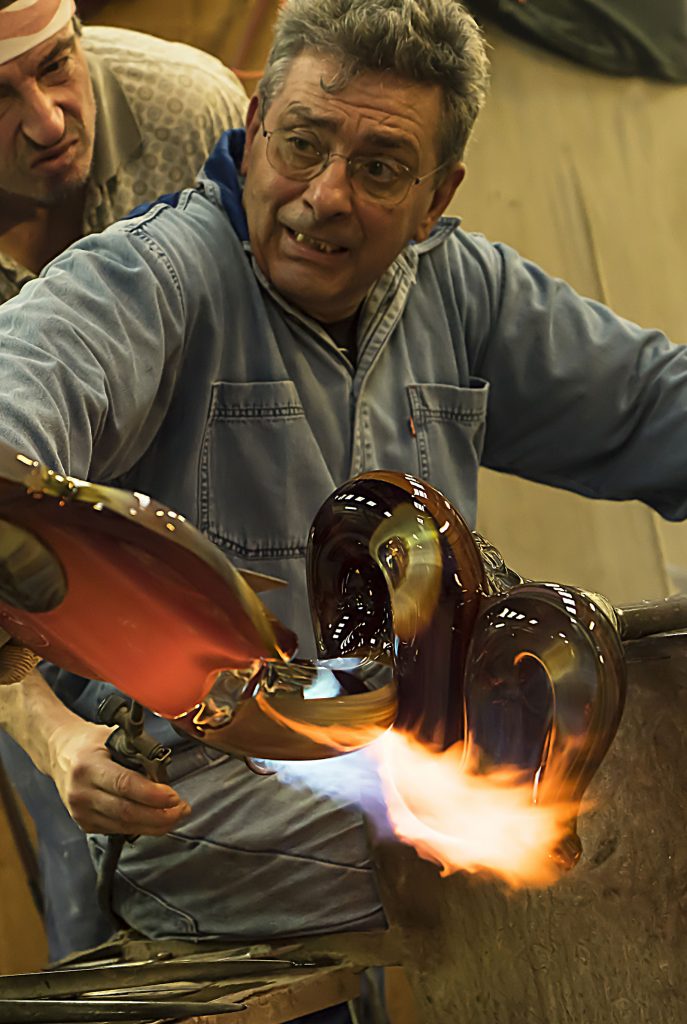Born in Venice on May 30th 1948, Dino Rosin was taken by his family while still an infant to live on Murano, the glassproducing island in the Venice lagoon. On leaving school at the age of 12, Dino began work straight away with much passion and dedication as an apprentice at one of the isle’s oldest and most renowned glass factories, “Barovier e Toso”.
His love for glass working gave him the chance to quickly earn a reputation, his energetic spirit letting him express his enthusiasm when modeling this unique material.
In 1963 he joined his brothers, Loredano and Mirco, owners of the “Artvet” glassworks.
Dino was fifteen years old, and he started working with his brother Loredano, who was gaining success as a new master glassworker It was then that Egidio Costantini, owner of the renowned Fucina degli Angeli(Angels’ Furnace), suggested that they came to collaborate with the most famous artists of the time: Picasso, Chagall, Jean Cocteau and Le Corbusier to mention only a few of the leading names who frequented his furnace-workshop.
The new idea entailed the recreation of these artists works in glass through the use of wholly new techniques and working methods. This experience allowed Loredano to start out on prestigious projects and Dino to re fine his talents through working alongside his brother.
Having gained the certainty and awareness of his artistic abilities in glass moulding, in 1975 Loredanodecided to realize one of his greatest ambitions: he opened a studio of his own where he would best accomplish his ideas by creating new and highly personal works of art.
It was not long before Loredano asked Dino to follow him in this new enterprise. The “adventure” was not without its risks and still today Dino remembers the warning of Francesco Zanetti called “Bea Ua”, his old master who feared that, by working as a support to his brother Dino would not manage to fully develop his natural abilities in shaping such a distinctive material as glass.
From that moment, instead, Dino began to develop his creative talents and at the same time perfect his techniques, following at first hand each and every stage of the production process: from the combining of the raw materials to the melting of the glass composition, to its coaxing in the furnace using personal ideas and inspirations and lastly to cold shaping – the phase at which Dino excels and indeed shows an almost unequalled skill. His cutting and grinding of large sculptures place him among the world’s best glass-artists.
For Dino, the feeling he experiences when working with glass is one of pleasure: the giving of form to his own ideas and the consolidating of his creative talent into objects that can be admired and touch ed.
In 1988, together with Loredano and the American glass artist Wiiliam Morris, he was invited to demonstrate his WOV at working molten glass at the “Pilchuck Glass School” in Washington State. It Is a collaboration that Dino has kept up with the school ever Since.
In 1991, however, the Rosin family was plunged into morning. Loredano. the much Loved brother, suffered fatal head injuries in a motor-launch collision in the waters of the Venice Iagoon. The tragedy deeply affected all the family and Dino was overcome by the loss. On recalling the, moment, he says “When I was brought the news about my brother I felt I had died along with him. I was literally shattered”.
It was only after some months that, with the help of his son, Diego – who in the meantime had gained his diploma in design at the Venice Art Institute – and the sincere support of his valuable colleagues, Dino managed to overcome this period of grief and concentrate again on his creations, this time with perhaps an even a greater commitment and tenacity than before.
Of those years intense work with his brother Loredano, Dino recalls: “Loredano and I,? … together…, it ‘s hard to explain, but I didn’t even need to speak to him; my development at his side became like symbiosis. My admiration, regard and total esteem meant that, each day, my pride grew stronger for staying beside him, humbly accepting his criticisms, or rather advice.
Today Dino Rosin, together with his brother, Mirco – who runs the organizational and administrative side of things, is dedicated to a new venture, “DINO ROSIN ARTE STUDIO s.r.l”.
each day he continues to create wonderful glass sculptures. His best works are on show at many prestigious art galleries throughout the world.
Along with the generous daily activity in producing his works, master glass-artist Dino shows a special sensitivity in following the training of new talents, among whom his san Diego, who after completing his studies and enrolling at the Accademia delle Belle Ratio, Venice, has come to work with his father for creating both new and established models.

